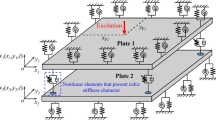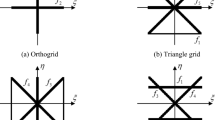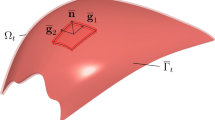Abstract
Double cable system (DCS) with a movable guide pulley (MGP) is a common component in many mechanical equipment. It is difficult to calculate the unstressed length of cable under a preload, and the form-finding analysis after obtaining the unstressed length. To solve this problem, a method of establishing double-layer nonlinear equations for calculating the unstressed length of cable under a given preload is proposed. For the inner single cable, a new cable element is presented based on Hermite interpolation. Later, initial cable form is obtained by approximating catenary as a three-point parabola, and the initial values for the nonlinear equations are derived. For the outer double cable, unstressed length is a descriptive variable of the DCS. In view of the constraints on a single cable posed by the guide pulleys, corresponding constraint equations are obtained by introducing the angle of rotation of the MGP, which is a process variable. Under a given preload at an end of single cable, equations for the DCS with a MGP are constructed. Moreover, the tangent stiffness matrixes are derived for quick solution, and unstressed length for the DCS is obtained. On this basis, by changing the partial constraint equations of the DCS, the form-finding analysis of the cable can be achieved. A few numerical examples and comparisons demonstrate the reliability of the proposed new approach for geometrically nonlinear analysis of cables.
Similar content being viewed by others
References
O. C. Zienkiewicz, R. L. Taylor and J. Zhu, The Finite Element Method: Its Basis and Fundamentals, 7th Ed., Butterworth-Heinemann Press, Oxford, UK (2013).
O. C. Zienkiewicz, R. L. Taylor and D. D. Fox, The Finite Element Method for Solid and Structural Mechanics, 7th Ed., Butterworth-Heinemann Press, Oxford, UK (2014).
J. Argyris and D. Scharpf, Large deflection analysis of prestressed networks, Journal of the Structural Division, 98 (3) (1972) 633–654.
J. P. Coyette and P. Guisset, Cable network analysis by a nonlinear programming technique, Engineering Structures, 10 (1) (1988) 41–46.
M. G. Yang, Z. Q. Chen and X. G. Hua, A new two-node catenary cable element for the geometrically non-linear analysis of cable-supported structures, Proceedings of the Institution of Mechanical Engineers. Part C, Journal of Mechanical Engineering Science, 224 (6) (2010) 1173–1183.
W. C. Qian, Generalized Variational Principle, Knowledge Publishing Press, Shanghai, China (1985).
X. C. Wang, Finite Element Method, Tsinghua University Press, Beijing, China (2003).
P. Shen, Y. M. He and Z. S. Duan, Wavelet finite element method analysis of bending plate based on Hermite interpolation, Applied Mechanics and Materials, 389 (2013) 267–272.
B. Xu, P. P. Dong and J. H. Zhang, A three dimensional approach to model steel wire ropes used in high energy absorber apparatus, International Journal of Solids and Structures, 51 (25–26) (2014) 4280–4293.
H. M. Ali and A. M. Abdel-Ghaffar, Modeling the nonlinear seismic behavior of cable-stayed bridges with passive control bearings, Computers and Structures, 54 (3) (1995) 461–492.
D. Wang and J. X. Liu, Application of the catenary curve’s equation in common condition, Ship and Ocean Engineering, 3 (2007) 26–28.
P. K. Park, P. B. Seo and P. S. Shin, Design of cable net-membrane roofs with reverse curvature by nonlinear analysis, International Journal of Latest Trends in Engineering and Technology, 9 (1) (2017) 113–118.
H. B. Jayaraman and W. C. Knudson, A curved element for the analysis of cable structures, Computers and Structures, 14 (3) (1981) 325–333.
D. Y. Cheng. Exact element method for analysis of cable structures, Ph.D. Thesis, Tsinghua University, Beijing, China (2005).
A. Andreu, L. Gil and P. Roca, A new deformable catenary element for the analysis of cable net structures, Computers and Structures, 84 (29) (2006) 1882–1890.
X. Liu, Nonlinear analysis of large span cable structure using a two-node curved element, Master’s Thesis, Guangxi University, Nanning, China (2004).
S. Hu, Y. L. He and Z. M. Wang, Nonlinear analysis of flexible cable structures using the finite element method, Engineering Mechanics, 2 (2000) 36–43.
M. G. Yang and Z. Q. Chen, The nonlinear finite element analysis for two-node catenary of cable structure based on UL formulation, China Civil Engineering Journal, 8 (2003) 63–68.
A. A. Salehi, A. S. Mostafa and E. Vahab, Nonlinear analysis of cable structures under general loadings, Finite Elements in Analysis and Design, 73 (2013) 11–19.
W. C. Knudson, Static and dynamic analysis of cable-net structures, Ph.D. Thesis, University of California, Berkely, California, USA (1971).
H. Wang and D. Xie, Analysis and experimental verification of the catenary component with the finite element method, Chinese Journal of Ship Research, 10 (6) (2015) 34–38.
J. M. Tang and J. S. Zhuo, An improved two-node cable element for large deformation analysis of cable structures, Journal of Hohai University (Natural Sciences), 4 (1999) 16–19.
X. F. Yuan and S. L. Dong, A two-node curved cable element for nonlinear analysis, Engineering Mechanics, 4 (1999) 59–64.
W. Z. Su, The nonlinear finite element analysis of cable structures, Master’s Thesis, Chongqing University, Chongqing, China (2005).
J. M. Tang, Z. Y. Shen and R. J. Qian, Finite element method with curved cable element for the nonlinear analysis of cable domes, Journal of Tongji University, 1 (1996) 6–10.
Y. Wang, C. Wu and S. R. Zuo, A finite element method with six-node isoparametric element for nonlinear analysis of cable structures, Applied Mechanics and Materials, 275–277 (2013) 1132–1135.
H. B. Chi, L. Chen and D. L. Wang, Research on the method about guy-rope retightening of all terrain crane, Construction Machinery, 11 (2013) 90–93.
C. G. Pan, Research on boom structure and superlift system of all terrain tuck crane, Master’s Thesis, Jilin University, Changchun, China (2014).
Y. F. Yang, W. X. Bai and J. D. Wei, Precision analysis of dynamic characteristics of cable using Ernst’s modified formula in cable-stayed bridge, World Earthquake Engineering, 2 (2008) 50–53.
J. G. Nie, B. L. Chen and J. C. Xiao, An improved algorithm for catenary cable element, Mechanics in Engineering, 4 (2003) 28–32.
K. H. Lee, Y. S. Choo and F. Ju, Finite element modelling of frictional slip in heavy lift sling systems, Computers and Structures, 81 (30) (2003) 2673–2690.
K. Kiani and M. Efazati, Nonlocal vibrations and instability of three-dimensionally accelerated moving nanocables, Physica Scripta, 95 (10) (2020) 105005.
K. Kiani and M. Efazati, Three-dimensional nonlocal-surface energy-based statics, dynamics, and divergence instability of movable cable-like nanostructures with arbitrary translational motion, Archive of Applied Mechanics, 91 (7) (2021) 3095–3123.
Z. H. Qi, J. Wang and G. Wang, An efficient model for dynamic analysis and simulation of cable-pulley systems with time-varying cable lengths, Mechanism and Machine Theory, 116 (2017) 383–403.
Y. IIyin, A. Nijhuis and W. A. J. Wessel, Axial tensile stress-strain characterization of 36 Nb3Sn strands cable, IEEE Transcations on Applied Superconductivity, 16 (2) (2006) 1249–1252.
Z. H. Qi. Dynamics of Multibody Systems, Science Press, Beijing, China (2008).
Y. B. Yang and J. Y. Tsay, Geometric nonlinear analysis of cable structures with a two-node cable element by generalized displacement control method, International Journal of Structural Stability and Dynamics, 7 (4) (2007) 571–588.
Acknowledgments
This work has been supported by the National Natural Science Foundation of China (Grant No.11872137 No.11802048 and No.91748203).
Author information
Authors and Affiliations
Corresponding author
Additional information
Jinshuai Xu received his B.S., M.S. degrees in Department of Mechanical Engineering from Dalian University of Technology, China, in 2006 and 2009, respectively. He has been engaged in product design for seven years in the field of engineering machinery design, and has become a senior engineer at the same time. In 2016, he entered the Department of Engineering Mechanics of Dalian University of Technology to study for a Ph.D. His main research interests include structural geometric nonlinearity and dynamic calculation of mobile cranes.
Zhaohui Qi received his Ph.D. in Department of Engineering Mechanics from Jilin University of Technology, China, in 1994. He is a Professor of the Department of Engineering Mechanics at Dalian University of Technology. His research interests include dynamics of multibody and complex mechanical systems.
Yingpeng Zhuo received his M.S. degree in Department of Engineering Mechanics from Dalian University of Technology, China, in 2020, and continue study for a Ph.D. in Dalian University of Technology. His research interests include dynamics of multibody and slender nested systems.
Rumin Teng received his Ph.D. in Department of Mechanical Engineering from Dalian University of Technology, China, in 2012. He is an Associate Professor of the Department of Mechanical Engineering at Dalian University of Technology. His research interests include control strategy of construction machinery and modern design theory and method of heavy equipment.
Tianjiao Zhao received his M.S. degree in Department of Engineering Mechanics from Dalian University of Technology, China, in 2017. In 2017–2019 previously worked on the design of trains and their computational analysis. He is currently studying at Dalian University of Technology for a Ph.D. His research interests include dynamics of rope pulley and truss systems.
Lingchong Gao received his B.S., M.S. degrees in Department of Mechanical Engineering from Dalian University of Technology, China, in 2012 and 2015, respectively. He is studying for a Ph.D. in Institute of Material Handling, Material Flow, and Logistics at Technical University of Munich, Germany. His research interests include dynamic analysis and control of slender structures in construction machinery.
Rights and permissions
About this article
Cite this article
Xu, J., Qi, Z., Zhuo, Y. et al. A new approach to geometrically nonlinear analysis of double cable system with a movable guide pulley. J Mech Sci Technol 37, 5263–5280 (2023). https://doi.org/10.1007/s12206-023-0928-1
Received:
Revised:
Accepted:
Published:
Issue Date:
DOI: https://doi.org/10.1007/s12206-023-0928-1




